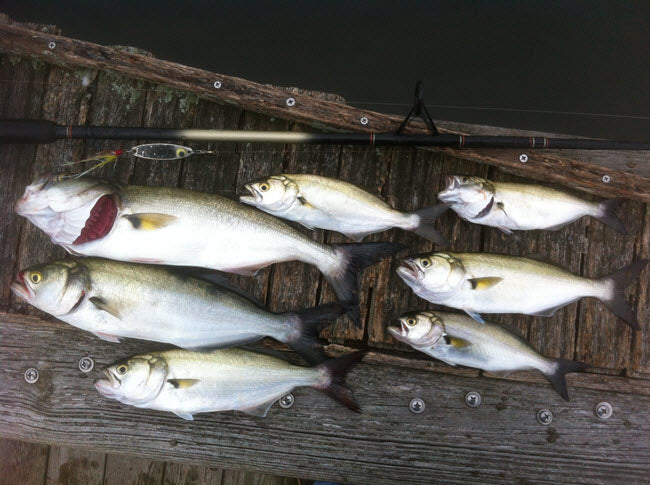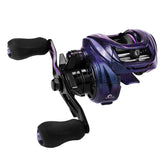
Why The Bad Rap On Bluefish?
On an early September Sunday afternoon, the kind of day picture postcards are made from, Summer’s warmth was still in play. A nice time to fish. And…have fun. Snappers, juvenile bluefish, run thick in the bay at that time of year. On light tackle they’re a blast to go fishing for. It’s been said about bluefish that pound-for-pound no other inshore game fish matches its fighting abilities and to find something that gives equal battle requires heading out to deep blue waters for tuna or marlin.
Yes, the young’uns are no different and easy to catch. All it takes is a shiny metal lure and a fast retrieve. Bluefish will chase anything. It’s why fishing for snapper bluefish is a great way to introduce kids to fishing. They grow razor sharp teeth, so you have to be careful with the bigger ones. If you put enough of them in the pail, they make a decent meal or a hearty appetizer. Bluefish have often been maligned. There’s an old joke told about cooking bluefish, which is often told when the subject comes up. The unknowing enjoy it…and believe it. According to the recipe, take one bluefish, filet and place on a board – cook it in the oven. Remove the fish and throw it away, eat the board; it will taste better than the fish. Well, yes, that can happen if you don’t know how to prepare and cook a bluefish properly.

Bluefish can be plentiful. Recently the bag limit for bluefish in NY waters has been greatly reduced.
Read on for a proven and tested recipe for bluefish table fare success that blows the bad-fish bluefish theory out of the water.
On bigger fish, three pounds and up, it’s best to bleed the fish immediately after coming off the hook. Some anglers make a small cut just before the gills, others, just before the tail. The key is not to kill the fish quickly. This process is meant to let the fish bleed by way of its heart pumping until it has bled out. Bluefish are oily and need to be iced immediately. Rig up whatever system you have to keep the fish out of the ice water.
Step two takes place while filleting. Fillet and skin the fish and remove the dark red blood-line from the center section of the fillet. If you are careful you can keep the fillet intact. Use a small, very sharp knife like a KastKing paring knife and work slowly.
Step three takes place in the kitchen. Soak the fillets in milk in a non-metallic dish and place in the fridge for at least 20 minutes. More is better, but not more than an hour. This step, along with removing the blood line, will eliminate the legendary notorious gamy taste. Remove the fillets and pat dry. Ditch the milk.
You can now choose from a variety of methods to season and cook your fish. Bluefish are a little more forgiving to the novice chef as they hold together better than some smaller, more delicate fish. Whatever way you decide to go, fry pan, grill or oven, you need to add an acid component. A simple time-tested method is drizzle the fish with white wine and cover with sliced tomatoes and onions, salt, pepper, a touch of oregano, salt and pepper. The wine and tomatoes have enough acid to get the job done. Bake at 400 degrees F for 20 minutes or until the fillets are white. Serve with the remainder of the wine and enjoy. Bluefish on the smoker is another way to go.
Smoked bluefish with a sour cream and horseradish sauce can be amazing. Combine the sour cream and horseradish in proportions that suit you. Start with the sour cream and spoon in the horseradish. Sample as you go. A little dill weed added to the mix is a nice touch.
Back to that Sunday afternoon. As nice of a day as it was, the southwest breeze was blowing from over my shoulder and pushing the baitfish off the beach. Big fish wouldn’t likely be around given the time of day and conditions, but one never knows. Quite frankly, I was too lazy to drive around to the other side of the bay where the action may have been better. I opted to enjoy the relaxed atmosphere and stayed. The tide was still coming in. Since it was past Labor Day, most of the crazies had returned to wherever they call home.

It was only me and another old-time angler on the beach. We acknowledged each other with nods of our heads. He had a radio with the Yankees game on and a beach chair. I had neither. He also had a few snappers in his pail. I think it was the top of the sixth when he decided to call it a day.
“Hey, I’m going to pack it in. I don’t have enough here for dinner. Why don’t you take these and add them to whatever you get,” he said as he poured his days’ catch into my yellow bucket. What a selfless act, I thought to myself. Well, if you’re not going to catch and release, or catch and fillet, I learned the next best option… catch and bequeath.












